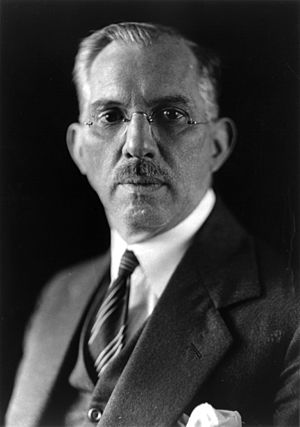Juan Bautista Sacasa facts for kids
Quick facts for kids
Juan Bautista Sacasa
|
|
|---|---|
 |
|
| President of Nicaragua | |
| In office 1 January 1933 – 9 June 1936 |
|
| Vice President | Rodolfo Espinosa Ramírez |
| Preceded by | José María Moncada |
| Succeeded by | Carlos Alberto Brenes |
| Vice President of Nicaragua | |
| In office 1 January 1925 – 14 March 1926 |
|
| President | Carlos José Solórzano |
| Preceded by | Bartolomé Martínez |
| Succeeded by | Enoc Aguado |
| Personal details | |
| Born | 21 December 1874 León, Nicaragua |
| Died | 17 April 1946 (aged 71) Los Angeles, California |
| Nationality | |
| Political party | Liberal |
| Spouse | María Sacasa Argüello Manning (1886–1981) |
| Relations | Benjamín Lacayo |
| Alma mater | Columbia University |
| Profession | Medical doctor |
Juan Bautista Sacasa (born December 21, 1874, in León, Nicaragua; died April 17, 1946, in Los Angeles, California) was a Nicaraguan doctor and politician. He served as the President of Nicaragua from January 1, 1933, to June 9, 1936. He was also the Vice President of Nicaragua before becoming president.
Contents
Early Life and Education
Juan Bautista Sacasa was born in the city of León, Nicaragua. His father was Roberto Sacasa, who had also been a president of Nicaragua.
Juan Sacasa went to school in the United States from 1889 to 1901. He studied medicine and earned his medical degree from Columbia University. After returning to Nicaragua, he became a professor and a dean at the National University in León. He supported the Liberal political party.
Political Beginnings
In 1924, Sacasa joined a group of politicians led by Carlos José Solórzano. Solórzano was a moderate Conservative. Around this time, U.S. Marines who had been in Nicaragua for 13 years left the country. They thought Nicaragua's political situation was stable.
However, in October 1925, Solórzano's government was overthrown. This happened when former President General Emiliano Chamorro took power. The U.S. did not recognize Chamorro as the new leader. So, he resigned, and Adolfo Díaz became president. During these events, Sacasa had to leave Nicaragua and went to Mexico.
Return and Civil War
In 1926, a civil war started in Nicaragua. Liberal soldiers began an uprising in Puerto Cabezas. Juan Sacasa returned to Nicaragua. He claimed he was the rightful president and set up a government in Puerto Cabezas.
Mexico sent weapons and supplies to the Liberal rebels. These rebels were led by General José María Moncada. They almost captured Managua, the capital city. But the U.S. stepped in and made both sides talk.
The Pact of Espino Negro
These talks led to an agreement called the Pact of Espino Negro. This pact said that both sides had to give up their weapons. It also allowed Adolfo Díaz to finish his term as president. Sacasa did not want to agree to this, but he accepted it. He refused to sign the pact himself and left the country. General Moncada signed the agreement for him.
After this, a Liberal general named Augusto Sandino started a guerrilla war. He fought against the U.S. Marines who stayed in Nicaragua to make sure the agreement was followed. This fight lasted for six years.
Presidency of Nicaragua
In 1932, Juan Sacasa was elected president of Nicaragua. He officially took office on January 1, 1933. This was just one day before the U.S. Marines were set to leave the country.
At the request of the U.S. Ambassador, Sacasa appointed Anastasio Somoza García to lead the Guardia Nacional. Somoza was married to one of Sacasa's nieces.
Meeting with Sandino
The next month, President Sacasa met with Sandino. Sandino promised to support the new government. In return, he and his followers received amnesty and land. However, Sandino kept asking for the National Guard to be disbanded.
In February 1934, Sandino was assassinated. This happened under orders from Somoza. Sacasa did not approve of this, but he could not control Somoza's growing power.
Challenges and Resignation
Sacasa's popularity began to decrease. Nicaragua's economy struggled because coffee prices dropped due to the Great Depression. There were also claims of cheating in the 1934 elections for Congress.
Meanwhile, Somoza's power grew stronger. He made alliances with former presidents Moncada and Chamorro. In early 1936, Somoza used the National Guard to remove local officials who were loyal to Sacasa. He replaced them with his own supporters.
On June 9, 1936, Somoza forced Sacasa to resign from his presidency. Somoza then appointed a temporary president who would follow his orders. The next year, Somoza himself became president. After resigning, Sacasa went to live in the U.S. He lived in Los Angeles until he passed away ten years later.
Family Life
Juan Sacasa married María Argüello Manning. She was a cousin of Leonardo Argüello, who later became the 66th President of Nicaragua.
Together, Juan and María Sacasa had four children:
- Maruca Sacasa Argüello
- Carlos Sacasa Arguello
- Roberto Sacasa Arguello
- Gloria Sacasa Arguello
See also
 In Spanish: Juan Bautista Sacasa para niños
In Spanish: Juan Bautista Sacasa para niños

